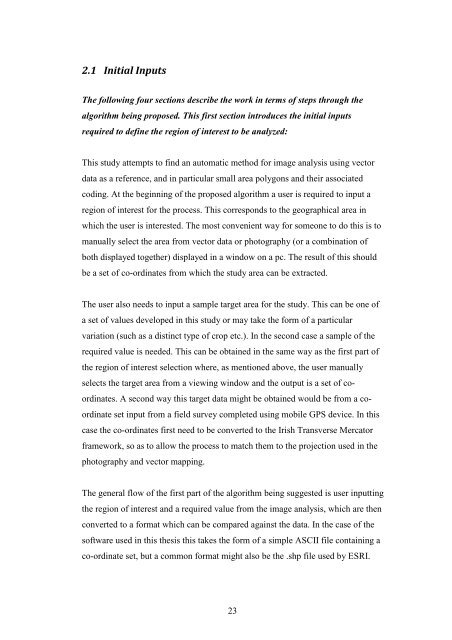You also want an ePaper? Increase the reach of your titles
YUMPU automatically turns print PDFs into web optimized ePapers that Google loves.
2.1 Initial Inputs<br />
The following four sections describe the work in terms of steps through the<br />
algorithm being proposed. This first section introduces the initial inputs<br />
required to define the region of interest to be analyzed:<br />
This study attempts to find an automatic method for image analysis using vector<br />
data as a reference, and in particular small area polygons and their associated<br />
coding. At the beginning of the proposed algorithm a user is required to input a<br />
region of interest for the process. This corresponds to the geographical area in<br />
which the user is interested. The most convenient way for someone to do this is to<br />
manually select the area from vector data or photography (or a combination of<br />
both displayed together) displayed in a window on a pc. The result of this should<br />
be a set of co-ordinates from which the study area can be extracted.<br />
The user also needs to input a sample target area for the study. This can be one of<br />
a set of values developed in this study or may take the form of a particular<br />
variation (such as a distinct type of crop etc.). In the second case a sample of the<br />
required value is needed. This can be obtained in the same way as the first part of<br />
the region of interest selection where, as mentioned above, the user manually<br />
selects the target area from a viewing window and the output is a set of co-<br />
ordinates. A second way this target data might be obtained would be from a co-<br />
ordinate set input from a field survey completed using mobile GPS device. In this<br />
case the co-ordinates first need to be converted to the Irish Transverse Mercator<br />
framework, so as to allow the process to match them to the projection used in the<br />
photography and vector mapping.<br />
The general flow of the first part of the algorithm being suggested is user inputting<br />
the region of interest and a required value from the image analysis, which are then<br />
converted to a format which can be compared against the data. In the case of the<br />
software used in this thesis this takes the form of a simple ASCII file containing a<br />
co-ordinate set, but a common format might also be the .shp file used by ESRI.<br />
23
















